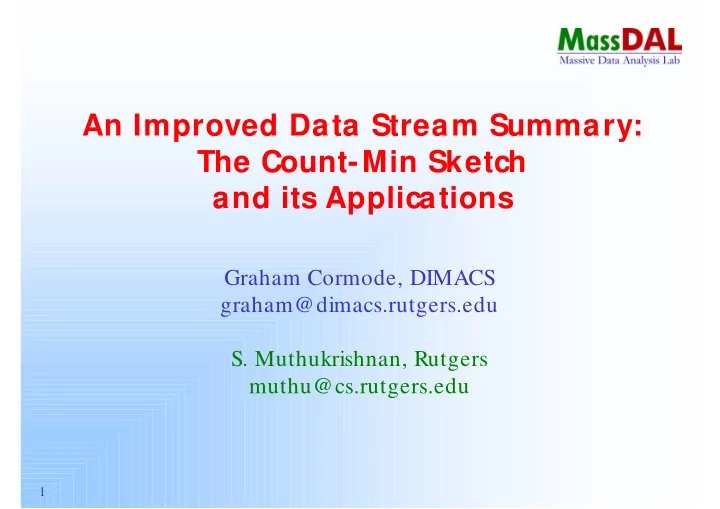

An Improved Data Stream Summary: The Count-Min Sketch and its Applications Graham Cormode, DIMACS graham@dimacs.rutgers.edu S. Muthukrishnan, Rutgers muthu@cs.rutgers.edu 1
Data Streams • Data is growing fast — faster than our ability to store or compute on it. • Information in Networks (phones, internet) Scientific data readings (satellites, sensor networks) Databases (financial transactions, etc.) • One approach: take one pass over data, summarize for later querying (for some class of queries): the data stream model 2
Data Stream Model • Data stream represents a high-dimensional vector a, initially all zero: for 1 ≤ i ≤ U . a[i] = 0 • n items in the stream: t'th update is (i(t), c(t)), meaning a[i(t)] is updated to a[i]+ c(t). • c may be negative in some cases, a[i] may or may not be allowed to be negative (here, assume non-negative; general case in paper) 3
Sketches "Sketches" are a class of data stream summaries • Typically, formed by linear projections of source data with appropriate (pseudo)random vectors • Introduced by Alon Matias & Szegedy in 1996 for estimating F 2 (later: L 2 norm, inner products) • Also: Indyk '00 for L 1 , L p norms Flajolet-Martin '83 for F 0 (distinct items) Charikar, Chen, Farach-Colton for point estimates 4
Limitations of Sketches So why do we need new sketches? • Space dependency is 1/ ε 2 for 1+ ε approximations: unusable for even reasonable values of ε < 1% . (for some problems 1/ ε 2 is a lower bound) • Update time often slow (linear in space), doesn't scale to network line speeds • Independence and randomness requirements sometimes excessive or unclear • Sometimes limited to one application 5
CM Sketch Count-Min Sketch sets out to solve all these problems. Gives simple, fast solutions for: – Point Estimation (Estimate a[i]) k a[i]) (Estimate Σ i= j – Range Sums (Estimate Σ i a[i]*b[i]) – Inner Products Applications to – Heavy Hitters (with departures) – Dynamic Quantile Maintenance 6
Point Estimation Point Estimation: given i return an estimate of a[i]. Set N = Σ c(t) = || a || 1 Replace the vector a with small sketch which approximates all a[i] upto ε N with probability 1- δ Ingredients: –Universal hash fns h 1 ..h log 1/ δ {1..U} � {1..2/ ε } –Array of counters CM[1..2/ ε , 1..log 2 1/ δ ] 7
Update Algorithm + count h 1 (i) log 1/ δ + count i,count + count h log 1/ δ (i) + count 2/ ε Count-Min Sketch 8
Approximation Approximate â[i] = min j CM[h j (i),j] Analysis: In j'th row, CM[h j (i),j] = a[i] + X i,j i,j = Σ a[k] | h j (i) = h j (k) X i,j ) = Σ a[k]*Pr[h j (i)= h j (k)] E(X ≤ Pr[h j (i)= h j (k)] * Σ a[k] = ε N/ 2 by pairwise independence of h 9
Analysis i,j ≥ ε N] = Pr[X i,j ≥ 2E(X Pr[X i,j )] ≤ 1/ 2 by Markov inequality Hence, Pr[â[i] ≥ a[i] + ε N] = Pr[ ∀ j. X i,j > ε N] ≤ 1/ 2 log 1/ δ = δ Final result: with certainty a[i] ≤ â[i] and with probability at least 1- δ , â[i]< a[i]+ ε N 10
Inner Products • Want to estimate Σ a[i]*b[i] • Estimate with min j Σ i CM(a)[i] * CM(b)[i] • Error is ε || a || 1 || b || 1 , similar Markov proof. • Result from AMS96: Error ε || a || 2 || b || 2 with space 1/ ε 2 log 1/ δ . • Which is better? Depends on distribution of a, b 11
12 Applications of CM Sketch Dynamic Quantiles Heavy Hitters
Heavy Hitters • See a sequence of items arriving (and departing?). Given φ , find all items occurring more than φ N times. • That is, find i for which a[i]> φ N • CCFC: Solve the arrivals only problem by remembering the largest estimated counts (in a heap) as items arrive, update sketch. • Here: find all heavy hitters with certainty, prob 1- δ of outputting an item with a[i] < ( φ −ε )N 13
Solutions with Departures • When items depart (eg deletions in a database relation), finding heavy hitters is more difficult. • Items from the past may become heavy, following a deletion, so need to be able to recover item labels. • Impose a (binary) tree structure on the universe, nodes correspond to sum of counts of leaves. • Keep a sketch for nodes in each level and search the tree for frequent items with divide and conquer. 14
Search Structure Find all items with count > φ N by divide and conquer (play off update and search time by changing degree) 15
Quantiles • Result of GKMS02: find quantiles with range sums • Eg Median: binary search for r so R(1,r) = N/ 2 • Can generalize for arbitrary quantiles • CM sketches improve space from O(1/ ε 2 ) to O(1/ ε ) • Time is O(log U log 1/ δ ) from O(1/ ε 2 log 2 U log 1/ δ ) 16
Implementations • Sketches running in AT&T Research's Gigascope network stream processing system, at 2.4Gbs • Code for CM sketch is publicly available http:/ / www.cs.rutgers.edu/ ~ muthu/ massdal-code-index.html 17
Recommend
More recommend